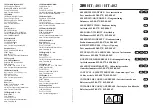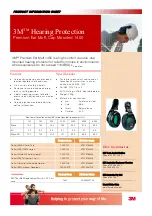
®
PS-3516
Introduction
3
012-15718A
1. Slide the sleeve of
the electrode FastFil
cap down to uncover
the fill hole. (see fig.
1)
2. Shake the electrode
downward like a
thermometer to
remove any air
bubbles trapped
inside.
•
The surface of the
Reference Fill
Solution in the
reference chamber
must be above the
inner junction. This is
approximately 3"
from the electrode tip.
3. Rinse the electrode with Dl water, blot dry. Do not
rub dry.
4. Soak the electrode in Dl water for 10 minutes, then
in a diluted Ammonium Standard Solution for two
hours prior to calibration or use.
Software Help
See the SPARKvue Help or PASCO Capstone Help for
information about collecting, displaying, and analyzing
data.
•
In SPARKvue, select the HELP button in any screen
including the Home Screen.
•
In PASCO Capstone, select PASCO Capstone Help
from the Help menu, or press F1.
Checking Electrode Operation (Slope)
1. Connect your electrode to the input connector on the
Wireless pH /ISE/ORP Sensor (or other measuring
device). Place 100 mL of DI water into a 150 mL
beaker. Add 2 mL Ammonium ISA to the DI water
and stir throughly.
2. Rinse the electrode with DI water, blot dry, and
place in the beaker with the prepared solution.
3. Pipet 1 mL of 1000 ppm Ammonium Standard Solu
-
tion into the beaker. Stir thoroughly, then record the
potential (E
1
) in mV when a stable reading is dis
-
played.
4. Pipet 10 mL of the same standard solution into the
beaker. Stir thoroughly. When a stable reading is
displayed, record the potential (E2) in mV.
5. The difference between the first and second poten
-
tial readings, (E2-E1), is defined as the electrode
slope. The normal range for the slope is 56±4 mV at
25°C.
Troubleshooting
If the electrode slope is not within the normal range, the
following procedure may restore the electrode.
1. Soak the electrode in a diluted standard solution for
2 hours before use.
2. Repeat "Checking Electrode Operation" procedure
again. Note: All standard solutions should be
prepared fresh. For best performance use ISA in all
solutions.
Periodically check the Reference Fill Solution level in the
reference chamber of the electrode. The solution level
must be higher than the inner junction which is visible as
a white ceramic pin on the inner body.
If the electrode slope is still outside the normal range
after this procedure, you must replace the sensing
module.
Reading a Sample with the Electrode
Various procedures may be used to determine the
concentration of a sample. The most common is the
Direct Calibration method, which is described below.
Contact PASCO's Technical Support department for
details of other methods.
In Direct Calibration a series of standard solutions of
differing concentrations is used to calibrate the
electrode. Then each sample requires only a single
meter reading, which is compared with the calibration
readings to obtain the sample concentration. ISA is
added to all solutions to ensure the samples and the
standards have the same ionic strength.
Set up:
1. Prepare the electrode as described in "Electrode
Preparation" and "Checking Electrode Operation".
Connect the electrode to the meter.
2. Prepare two standard solutions that differ in
concentration by a factor of ten and bracket the
expected sample concentration range. For example,
if your expected sample concentration is 5 mg/L
Fill Hole
FastFil Cap sleeve
Minimum fill level for the
Reference Filling Solution
Minimum immersion depth
Reference Junction
Figure 1
DO NOT immerse above
this point.























